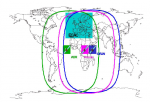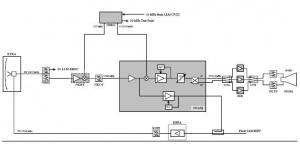If you wish to contribute or participate in the discussions about articles you are invited to contact the Editor
EGNOS Space Segment: Difference between revisions
Carlos.Lopez (talk | contribs) No edit summary |
Carlos.Lopez (talk | contribs) No edit summary |
||
| Line 1: | Line 1: | ||
{{Article Infobox2 | {{Article Infobox2 | ||
|Category=EGNOS | |Category=EGNOS | ||
|Editors=GMV | |Editors=GMV | ||
|Level=Basic | |Level=Basic | ||
|YearOfPublication=2011 | |YearOfPublication=2011 | ||
Revision as of 11:12, 23 February 2012
| EGNOS | |
|---|---|
| Title | EGNOS Space Segment |
| Edited by | GMV |
| Level | Basic |
| Year of Publication | 2011 |
The EGNOS space segment is composed of three geostationary satellites centred over Europe:
- Inmarsat-3 AOR-E (Atlantic Ocean Region East) stationed at 15.5° W.
- Inmarsat-3 IOR-W (Indian Ocean Region West) stationed at 25.0°E.
- ESA-Artemis stationed at 21.5° E.
The main criteria followed in the selection of the satellites positions have been:
- Improve the measurement geometry and hence the system availability.
- Maximise the visibility angle diversity and hence minimise the risk of signal blocking.
- Provide dual geostationary coverage (minimum) within the core service area.
Inmarsat’s Third Generation satellites carry a navigation payload which is used by EGNOS.[1]
The first Inmarsat-3 (F2 AOR-E) satellite carrying an EGNOS transponder was launched in September 2006 (PRN 120) while the second one, Inmarsat-3 F5 IOR-W, was launched in February 1998.[2]
Inmarsat-3s were built by Lockheed Martin Astro Space (now Lockheed Martin Missiles & Space) of the USA, responsible for the basic spacecraft, and the European Matra Marconi Space (now Astrium), which developed the communications payload, being the first satellite launched by the Proton launch vehicle.
The ESA ARTEMIS satellite is not an ordinary telecommunications satellite. It incorporates new, advanced technologies that expand and improve all areas of navigation, mobile communication and satellite-to-satellite communications. Having reached its final orbital position on 31st January 2003, ARTEMIS soon began delivering its planned data-relay, land-mobile and navigation services. In particular, its L-band land mobile payload is being used to complement and augment the European Mobile System, its data-relay payloads are being prepared to provide operational services to ENVISAT and SPOT-4, and its navigation payload is a major operational element of the European Global Navigation Overlay Service (EGNOS).[3]
The Artemis navigation payload was introduced at a very late stage of the ARTEMIS satellite development and a very tight schedule was imposed on its procurement. As a consequence and to minimize all possible impacts, it was decided to design it as a completely separated structure, to be installed on the spacecraft top floor. Additionally, the payload design and the relevant pieces of equipment were approached, by maximizing the use of already available commercial products and avoiding as much as possible new technologies.
The technical design drivers for the navigation payload were the following:
- Appropriate frequency selection for compatibility with other existing missions;
- Good control of the group delay stability;
- Electrical and mechanical constraints imposed by the existing ARTEMIS hardware;
- Maximum reuse of off-the-shelf equipments for minimum schedule risk.
All units are redounded in order to meet the specified mission probability target of 0.7 of meeting full performance requirements for 10 years on-station life (inclusive of spacecraft). The total mass for the navigation payload, including the structure, the thermal control hardware and the DC harness is 25 kg. Its total power consumption is in the order of 110 W.
GEO Replenishment options
In the frame of future evolutions for the EGNOS Space Segment, the following three options were identified for the EGNOS GEO replenishment:[4]
- Next Generation of Inmarsat Satellites.
- Piggy Back Navigation Payload in a planned GEO multi-mission satellite.
- In the context of integration of EGNOS into Galileo, the implementation of GALILEO GEOs providing EGNOS links.
At the time of this edition (July 2011), the replacement of the EGNOS transponder on Artemis (by Astra Sirius) and Inmarsat 3F2 (by Astra 5B) are foreseen by beginning of 2014 and beginning of-2015 respectively.[5]
Notes
References
- ^ EGNOS Programme Evolution (EGNOS Portal)
- ^ EGNOS GEO Replenishment: Planning for the Future; Javier Ventura-Traveset, European Space Agency; Sally Basker, SBAS Limited; Ken Ashton, National Air Traffic Service Ltd.
- ^ EC-DG Energy and Transport, “The European GNSS Programmes: EGNOS and Galileo”, Feb. 2011




